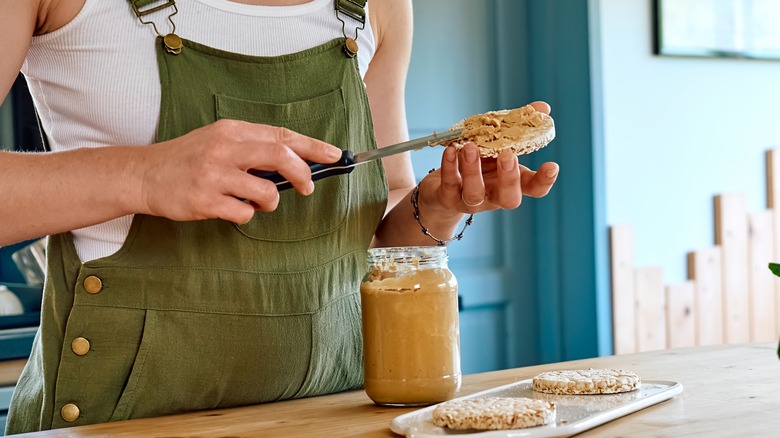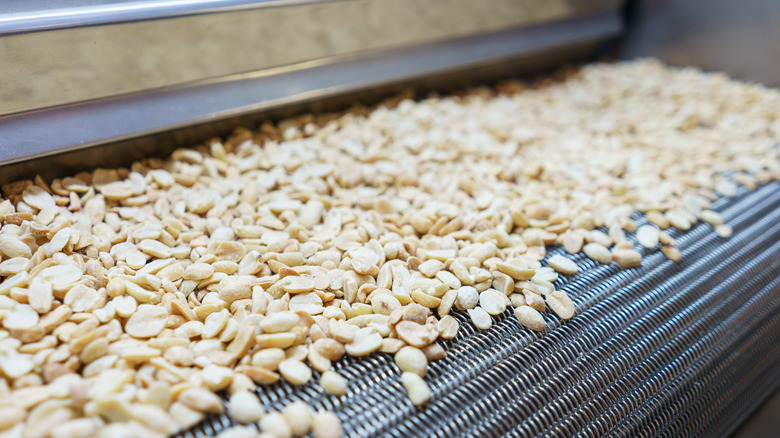Can You Get Salmonella From Peanut Butter?
Dairy products, raw eggs, and undercooked meat or poultry are a few of the various food items that can put one at risk for salmonellosis, explains the U.S. Food and Drug Administration (FDA). Stemming from infection with Salmonella bacteria, people who contract salmonellosis often experience fever, cramping, or gastrointestinal symptoms, like diarrhea. In some cases, however, a salmonella infection can be life-threatening, resulting in an estimated 450 deaths annually in the U.S.
While you might not think of nut butters as a common source of salmonella, outbreaks have occurred from contaminated peanut butter products. Such was the case in 2022, when J.M. Smucker Company elected to recall Jif peanut butter products produced out of their Kentucky facility as the FDA issued an investigation into an associated salmonella outbreak. In fact, 2022 research published in the scientific journal Foods notes that salmonella can survive in peanut butter throughout the duration of the product's shelf life. With the U.S. consuming the greatest amounts of peanut butter globally, here's what to know about salmonella contamination.
How does salmonella make its way into peanut butter?
The researchers outlined that one of the reasons people may believe peanut butter is low-risk for salmonella contamination is because it has a low moisture content (via Foods). Following roasting, peanuts have a moisture content of only about 3%. Furthermore, the final product is calculated to have a water activity (aw) measurement of approximately 0.35, which seems low-risk when you consider that salmonella requires about 0.99 water activity to grow.
Yet this doesn't make peanut butter immune to potential bacterial contamination. Rather, peanuts' low moisture content may be one factor that supports potential salmonella contamination in peanut butter. This is because bacteria can become heat-resistant in foods that are low in moisture, but simultaneously high in protein, sugar, and/or fat (like in peanut butter). Past cases of salmonella outbreaks have been traced to contaminated water used in processing facilities. Michael Doyle, director of the Center for Food Safety at the University of Georgia in Griffin, told Scientific American that exposure to animal fecal matter is one way in which the water may become contaminated.
Measures to reduce the risk of salmonella contamination in peanut butter
Echoing Doyle's statement to Scientific American, author of "Food Safety: Past, Present, and Predictions," Darin Detwiler told Health, "Most cases of Salmonella in peanuts are caused by the presence of rainwater bringing feces onto the product, or animals — birds, or more likely rodents — [coming] directly] into contact with the product." While peanut butter is not considered as high-risk as eggs or raw meat, experts continue to call for further study and improvements in manufacturing practices to help reduce the chances of salmonella contamination in the making of peanut butter products.
One key piece of this puzzle is proper peanut roasting. When roasted at higher temperatures for a longer period of time, such practices can help eliminate salmonella in peanuts. Doyle also spoke to UGA Today, explaining that peanuts need to be roasted at more than 190 degrees Fahrenheit for more than 40 minutes to be rid of salmonella, yet this may potentially affect peanut butter's quality. One way we can help protect ourselves from salmonella, however, is to sign up for notifications from the U.S. Department of Agriculture (USDA) to stay up-to-date on food recalls.
To learn more, here's the best way to treat a salmonella infection.



